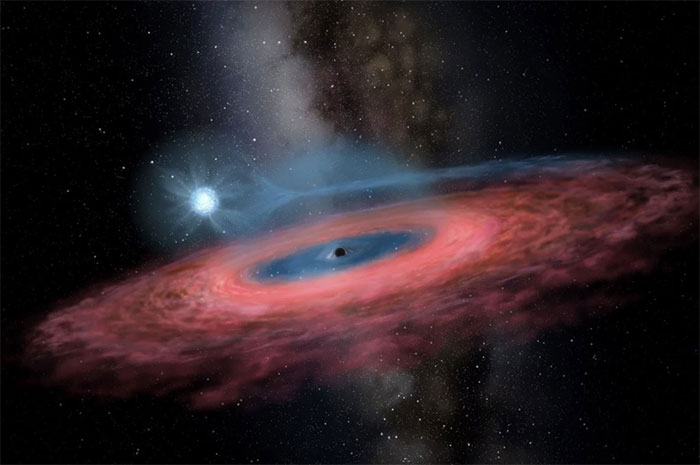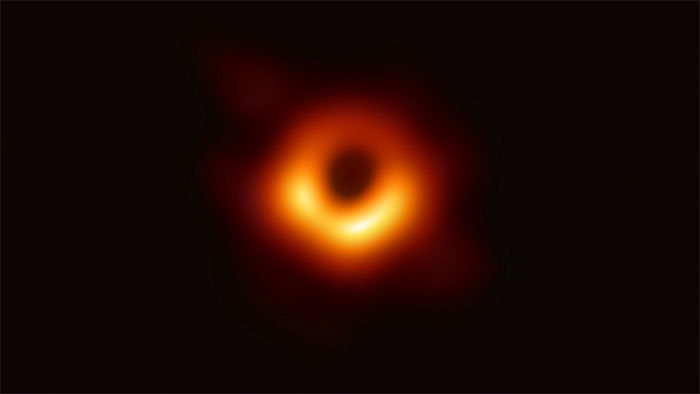The giant black hole in the Milky Way is just a mistake?
The giant black hole challenging every theory published in November could be a mistake only by scientists.
In November, scientists at the China National Astronomical Observatory announced a black hole with the mass 70 times more massive than the Sun, right inside the Milky Way. This black hole is called LB-1 .
Theoretically, a star the size of our Sun cannot create a black hole the size of LB-1. Therefore, the mass of LB-1 is expected to challenge the evolutionary theory of black holes so far.

LB-1 black holes challenge all theories about the evolution of stars.(Photo: AFP).
"It is impossible to explain the existence of this black hole with its initial mass, stellar wind (star process of material loss) or thermonuclear reaction. It changes our perception of the process. "the evolution of stars and the formation of black holes , " said astronomer professor Li Xiangdong of Nanjing University.
Data is not tight
"LB-1 is twice as big as we calculated. Theoretical physicists will have to find a way to explain its formation , " said Liu Jifeng, a researcher at China National Astronomical Observatory. .
Although Liu Jifeng said he and his colleagues have verified with astronomers around the world until three years of publication of the findings, two newly published scientific papers have sought to explain the errors. Mistakes can lead to observations on.

Black holes are still a big challenge for scientists.(Photo: Science Daily).
First, it is necessary to understand how Chinese scientists come to the conclusion of a giant black hole. They observed two light sources at a distance of about 15,000 light-years from Earth, including a very fast moving light source, called star B, and a light source with a lower intensity and moving very slowly, called the Hα light line.
Based on how the two light sources interact with each other, scientists can calculate the mass of the object emitting the Hα light path . It is like a player spinning around: he only needs to move his abdomen a very small distance to cycle around his belly at a much higher speed.
"We already have a B star, and that's just one component of this phenomenon. Black holes are the rest. We can observe the two events and connect them together," says Jackie Faherty, home. explained astronomy at the New York History Museum.
According to Live Science, the problem is that human telescopes don't have enough resolution to directly observe events far away like this. In fact, scientists must calculate the motion of objects based on changes in the observed wavelength.
More specifically, we will calculate the velocity, the distance star B moves based on the Doppler effect, when the frequency from the emitted wave is changed based on the distance. Scientists can also calculate the parameters of the object emitting the Hα light line, and from there conclude this is a giant black hole.
The problem with this conclusion, according to newly analyzed scientific papers, is that they have been unable to isolate data from starlight B and Hα lines. In other words, it is possible that the Hα curve could result from an optical effect from the star B's own light, not from an extremely massive object. In that case, the object emitting the Hα light line was completely motionless.
The two wrong interpretations mentioned above
"After making a mistake about the data, it became very simple. I think most astronomers will understand the problem and agree," said Leo C. Stein, an astronomer at the University of Mississippi. tell Live Science.

Previously, scientists thought that a giant black hole could only form when two smaller black holes collided and merged into one, creating gravitational waves.(Photo: Swinburne Astronomy Productions).
According to astronomers Kareem El-Badry and Eliot Quataert, the author of one of the two papers, when the object is not moving, can come to two possibilities. The first possibility is that the black hole also has many times more mass than originally calculated, so its motion becomes very small, unobservable.
"We think this possibility is very unlikely , " the two authors said.
The higher possibility, according to a paper published by Belgian scientists, is that the Hα sugar comes from an unknown source. A group of objects observed by Chinese scientists could still have a black hole, but it is only the size of the sun. This ability is consistent with current astronomical theories, which cannot explain why a giant black hole like LB-1 exists in the Milky Way.
"This is how science moves forward. Scientists will note problems that might cause us to rethink theories of evolution. However, scientists also need to retest. thoroughly research the work of others, and this is the case, " said Jackie Faherty.
- Monster black holes are 100,000 times bigger than the Sun.
- The center of the Milky Way may contain thousands of black holes
- The supermassive black hole in the center of the Milky Way is 'hungry' like never before
- Detecting a black hole
- The star flies more than 1,000 km / sec after 'hiding' from the black hole
- Discover the mystery of the most exotic black holes in the universe
- 'Shocking' about the Milky Way and black holes 'wandering'
- Discovering the Milky Way's new black hole
- Witness the 'meal' of the super black hole
- The galaxy's giant black hole
- Spending $ 19 million to get the first picture of black hole history
- The endless dance between the Milky Way
 Van Allen's belt and evidence that the Apollo 11 mission to the Moon was myth
Van Allen's belt and evidence that the Apollo 11 mission to the Moon was myth The levels of civilization in the universe (Kardashev scale)
The levels of civilization in the universe (Kardashev scale) Today Mars, the sun and the Earth are aligned
Today Mars, the sun and the Earth are aligned The Amazon owner announced a secret plan to build a space base for thousands of people
The Amazon owner announced a secret plan to build a space base for thousands of people